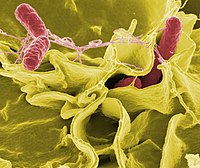
Photo from wikipedia
Introduction. Non-typhoidal Salmonella (NTS) bacteremia can cause significant morbidity and mortality. There is high incidence of Salmonellosis in the Middle East, including Israel, but there is a paucity of data… Click to show full abstract
Introduction. Non-typhoidal Salmonella (NTS) bacteremia can cause significant morbidity and mortality. There is high incidence of Salmonellosis in the Middle East, including Israel, but there is a paucity of data on the clinical and epidemiological features of children in comparison to adults.Hypothesis/Gap Statement. Previous studies describing the differences between paediatric and adult populations with Salmonella bacteremia are sparse.Aim. This study's aim was to describe the differences between adults and children with NTS bacteremia.Methodology. All records of patients with NTS bacteremia between 1 January 1998 and 31 July 2020 were reviewed. Data regarding clinical manifestations and laboratory results were extracted from the medical records; records of children (aged <18 years) were compared with those of adults.Results. Records for 137 cases of Salmonella bacteremia (69 adults and 68 children, aged 2 days to 98 years) were reviewed. Seventy nine (58 %) patients had concomitant gastrointestinal symptoms. Fifty-eight (84 %) adults and 13 (19 %) children had underlying conditions (P<0.001). Eighteen patients died, none of whom was a child. Over the study period, most of the children (n=46, 67 %) but only five adults were discharged from the emergency department on their first visit to the ED.Conclusions. The main characteristics of NTS bacteremia in children compared to adults, are higher rates of prior discharge from emergency department, higher rate of gastrointestinal symptoms and better prognosis.
Journal Title: Journal of medical microbiology
Year Published: 2022
Link to full text (if available)
Share on Social Media: Sign Up to like & get
recommendations!